In-Depth Damage Guide
Last Updated:June 29, 2025|Changelog
This In-Depth Damage Guide exists to answer the age-old question, "Is this random item a damage increase?". The guide includes everything that influences your damage in Diablo 4, and each section covers a part of the damage formula. To access all relevant in-game information, you must enable an in-game setting called Advanced Tooltip Information under Options > Gameplay > Advanced Tooltip Information. Additional information, such as Skill %, now appears while hovering over skills.
When calculating your Average damage, hover over your additive damage and use the bottom value on the tooltip instead of the top value, as the top value is influenced by [Global Damage Multipliers]. The top value is only used to scale certain multipliers and those cases are listed in our Build Guides.
General Damage Formula
This section covers the structure of the general damage formula used to calculate the damage you see in-game. Each section of this guide refers to sections of this formula and explains how it functions in detail. The general formula can be described in the following way:

The following is a more math-focused version of the damage formula and includes the math of each respective multiplier:

This is just average damage without including variance and without including attack speed. Damage values in Diablo 4 have quite a significant range, which means you see values far higher and lower than the calculated average damage. You can find more information about this in the variance Section. The final part of the formula accounts for Enemy Damage Reduction, which may be replaced by [0.15] if you are level 60.
The damage formula changes slightly when we look at flat damage effects such as X'Fal's Corroded Signet or Thorns. The part that changes is that the [Average Weapon Damage] and [Skill %] multipliers are removed and replaced with [Flat Damage]. As of Season 4, flat damage sources like X’fals now have weapon damage scaling in the damage value seen on the item, which means that [Flat Damage] is the damage value you see on the item or the Thorns total you have on your character.
Multiplicative Damage Sources
The term "Global Multipliers" is used in the general damage formula, and it is quite simply just that, a multiplier to all your damage dealt as long as the condition is met. Some have the condition that the target must be poisoned, while some require you to cause a critical strike. These multipliers are generally identified by having [x]% in their tooltip, such as the unique effect on The Grandfather. All of these are multiplied together and are included in the damage formula in the following way:

Due to how percentages work, we have to make sure that we add a +100% as a base so that the multipliers become an increase of the appropriate percentages. To use a practical example, if you have 3 ranks of Malice, Frigid Finesse: Frozen, and Weapon Mastery: Crossbow, then your total damage increase from the global multipliers would be:

Global Multipliers are largely independent of your stats from items and paragon points and, as such, do not increase the amount of stats you have. For example, you have a [x]30% multiplier vs Frozen enemies from Frigid Finesse regardless if you have [+]0% Damage vs Frozen enemies or [+]300000% Damage vs Frozen enemies. However, certain skills, passives, and legendary paragon nodes may have increased effectiveness by having more of a specific stat. One example is the Precision keystone passive for rogues, which scales in strength based on your [+]Critical Strike Damage%.
To know what global multipliers affect your build and skills, you must either test it yourself or refer to relevant build guides. For example, despite Weapon Mastery: Swords stating that you deal [x]% more damage, it does not increase the damage of Poison Imbuement You would not learn this information from reading the tooltips, it is something you would have to test yourself to verify.
Additive Damage Multiplier
The Additive Multiplier is the sum of all stats commonly referred to as "additive damage". The stats on your items with [+]% are additive bonuses and added together into one multiplier (also known as a “bucket”) called the [Additive Damage Multiplier]. There are two important prospects to remember when it comes to additive damage. The first is that their value entirely depends on how frequently their condition is met, and the second is diminishing returns.
Remember to hover over the additive damage stat and use the bottom value when using calculations, as the top value is influenced by [Global Damage Multipliers].
First, regarding conditional damage bonuses, if you compare +30% Close Damage with +60% Vulnerable Damage, it may look like Vulnerable Damage would be the way to go because the number is larger. If you only have 10% uptime on Vulnerable and are always near your target, Close Damage would still be worth +30% additive damage, while the +60% Vulnerable Damage averages to +6% Additive damage. Uptime, meaning how frequently the condition is met, matters when you assess how valuable an additive damage stat is.
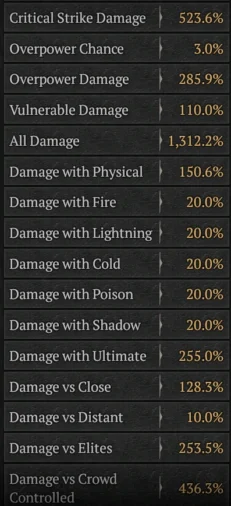
The second prospect, diminishing returns, is one of the most important concepts when optimizing your damage. For example, adding +60% additive damage when you have no additive damage stats compared to when you have +800% additive damage already gives vastly different results. If you have no additive damage bonuses, the additive multiplier has a base of “100%” for the same reason described in the multiplicative damage section. If we add +60% additive damage to our additive multiplier, we get 100% + 60% = 160%. To calculate how much of a gain this is, we can calculate the relative increase using the following formula:

Based on the example values listed above, we would then put (100% + 60%)/(100%) = (160%)/(100%) = 1.6. This means that 160% is 1.6 times as large as 100%, and we deal, as such, 1.6 times more damage.
Comparing this gain to if we added another +60%, our formula would be the same, but the values would change. Our Old Additive Multiplier would be 160%, and our New Additive Multiplier would be 160% + 60%. (160%+60%)/(160%) = (220%)/(160%) = 1.375. In other words, adding another +60% means our damage increases by a factor of 1.375 (37.5%) and not 1.6 (60%) like it did the first time we added +60% additive damage. This is called diminishing returns.
You must understand this concept to optimize your damage potential, as certain builds have over +2000% additive damage. So adding another +60% Close Damage would only be an increase of:

In other words, if you add +60% Close Damage when you already have +2000% additive damage, you would only see a 2.85% overall increase to your damage dealt.
Additive Damage or Multiplicative Damage?
Sometimes, you run into a situation where it is more convenient to calculate how much a specific stat is worth compared to the damage increase of a Global Multiplier. As a general rule of thumb, a Global Multiplier is often worth more than the relative gain you would see from adding other stats in the endgame, but it is not always obvious. You can calculate precisely how much, for example, [+]Additive Damage would be equal to a [x]% global multiplier using the following formula:

So, assuming you have [+]1000% Additive damage from stats and paragon points, and you want to compare it to a [x]10% Global Multiplier. We can calculate that 1.1 x (100% + 1000%) - (100% + 1000%) = 110% Additive Damage, in this example, equals the gain of a [x]10% global multiplier. This works for other multipliers too, such as Main Stat. All you have to do is change the [Additive Multiplier] to the [Main Stat] multiplier.
Vulnerable
Vulnerable Damage is dealt when you damage a target affected by Vulnerable, a condition applied by certain skills and effects. As of patch 1.2.0, [+]Vulnerable Damage% was changed to a conditional additive damage stat in the [Additive Damage Multiplier] instead of being added to a separate multiplier.
Additive Vulnerable Damage
[+]Vulnerable Damage% is a conditional additive damage stat and is thus comparable to Close Damage and other conditional additive damage stats.
If you were to hover over the tooltip for Vulnerable Damage, you would see a percentage at the top and one at the bottom. The bottom value on the tooltip, [+]47%, is the sum of all [+]Vulnerable Damage% from your items and Paragon. This value is only increased by items and Paragon and is not influenced by talents, skills, or aspects.
Use the bottom value for damage calculations, as the top value is affected by [Global Damage Multipliers] and is thus inaccurate.
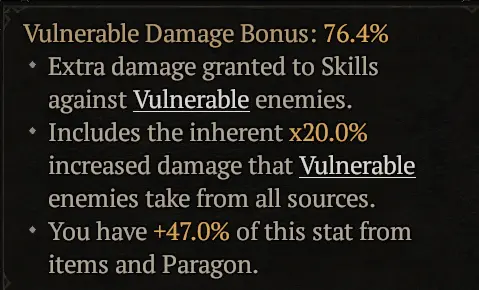
Multiplicative Vulnerable Damage
There is a baseline 20%[x] multiplicative damage bonus when you hit a Vulnerable target. This is listed on the tooltip as "includes the inherent x20.0% increased damage that Vulnerable enemies take from all sources", and it cannot be increased by any means. It is applied to the damage calculation as a [Global Damage Multiplier].
There are multiple other Multiplicative Vulnerable Damage sources in the game, and they are all marked as [x], such as Malice, Weapon Mastery: Bow, Shredding Blades, and others. These function as individual [Global Damage Multipliers], making them incredibly powerful for Vulnerable Damage builds.
Critical Strikes
Critical Strike Damage (henceforth CSD) is done when your damage causes a Critical Strike. As of patch 1.2.0, [+]Critical Strike Damage% (henceforth [+]CSD%) was changed from being added to a separate multiplier to a conditional additive damage stat in the [Additive Damage Multiplier]. Do note that generally speaking, Damage over Time effects cannot critically strike, but there are unique situations, such as Blended Poison Imbuement, which causes Critical Strike Chance to have value for Damage over Time builds.
Additive Critical Strike Damage
[+]CSD% is a conditional additive damage stat in the [Additive Damage Multiplier]. In other words, [+]CSD% has the same function as Close Damage and other conditional additive damage stats.
If you were to hover over the tooltip for CSD, you would see a percentage at the top and one at the bottom. The bottom value on the tooltip, [+]410.1%, is the sum of all [+]CSD% from your items and Paragon. This value is only increased by items and Paragon and is not influenced by talents, skills, or aspects.
Use the bottom value for damage calculations, as the top value is affected by [Global Damage Multipliers] and is thus inaccurate.
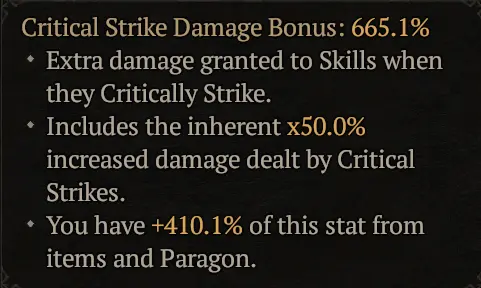
Multiplicative Critical Strike Damage
There is a baseline 50%[x] multiplicative damage bonus when you cause a Critical Strike. This is listed on the tooltip as "includes the inherent x50.0% increased damage dealt by Critical Strikes", and cannot be increased by any means. It is applied to the damage calculation as a [Global Damage Multiplier].
There are multiple other Multiplicative Critical Strike Damage sources in the game, and they are all marked as [x], such as The Grandfather, Frostbitten, Golems - Iron, etc. These function as individual [Global Damage Multipliers], making them incredibly powerful for Critical Strike Damage builds.
Damage Value of Critical Strikes
It is important to note that the value of Critical Strike Damage is relative to the amount of Critical Strike Chance (henceforth CSC) you have. The formula to calculate the average damage done per hit, including CSC, is divided into two parts. The first part is [100% - CSC%] x [100% + Additive Damage], which is how much damage you do when you do not cause a Critical Strike. The second part is [CSC%] x [100% + Additive Damage + [+]CSD%] x [100% + [x]%CSD], which is how much damage you do when you cause a Critical Strike. The [100% + [x]%CSD] multiplier is the product of all the global multipliers with Critical Strike Damage bonuses. Combined, the Critical Strike Average Damage becomes the following:

So in a scenario where you would compare adding [+]100% unconditional Additive Damage or [+]150% CSD% if you had 40% CSC, you would have to do the following calculations:

Because 2.4 > 2.1, it would be better to add [+]100% unconditional Additive Damage compared to adding [+]150% CSD%. The math would work out similarly regardless of the [+]Additive Damage and [+]CSD% we would have initially. However, there is a convenient way to calculate the relative value of [+]CSD% compared to unconditional Additive Damage, and it is with the following formula:

Using this formula, we can see that if we have 40% CSC and a [x]%CSD of 50%, we get: 100% - [(100% - 40%)/(100% + 40% x 50%] = 100% - 50% = 50%. So [+]CSD% is worth 50% of unconditional Additive Damage. Let us try this theory by plugging in [+]200% CSD% in our average damage calculation with the same context as before:

This formula works for all damage conditions where we have [+]% and [x]% damage bonuses with the same condition. If we, instead, wonder how much damage additional [+]CSD% would give us, we can use the relative gain formula shown in the [Additive Damage Multiplier] section.
Overpower
Overpower Damage (henceforth OPD) is a conditional damage modifier that turns your damage value cyan for non-critical strikes, and orange for critical strikes. This has a set 3% probability of occurring normally, but certain skills, passives, and aspects can guarantee that a skill Overpowers. Unlike Critical Strikes, attacks Overpower cast rather than per hit, meaning that abilities with multiple hits in one Overpowers each hit. Do note that Damage over Time effects and Channeled abilities cannot Overpower under any circumstance.
Additive Overpower Damage
[+]Overpower Damage% (henceforth [+]OPD%) is a conditional additive damage stat in the [Additive Damage Multiplier]. In other words, [+]OPD% has the same function as Close Damage and other conditional additive damage stats.
If you were to hover over the tooltip for Overpower, you would see a percentage at the top and one at the bottom. The bottom value on the tooltip, [+]219.8%, is the sum of all [+]OPD% from your items and Paragon. This value is only increased by items and Paragon and is not influenced by talents, skills, or aspects. This does not include the [+]OPD% you get from Health and Fortified.
Use the bottom value for damage calculations, as the top value is affected by [Global Damage Multipliers] and is thus inaccurate.
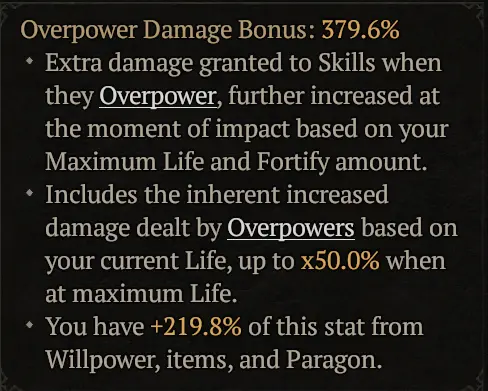
Multiplicative Overpower Damage
There is a separate 0%-50%[x] multiplicative damage bonus when you Overpower that scales depending on your current health (with 50% being the max when you are at full health). This multiplier cannot be increased by any means and is applied to the damage calculation as a [Global Damage Multiplier]. This Multiplier is applied based on your current health when you cast your ability, and is calculated the following way:

So if you have 50% HP, your multiplier would be: 100% + 50% x (50%/100%) = 125% = [x]25%. On top of this, there are also other Multiplicative Overpower Damage sources in the game, and they are all marked as [x], such as Earthstriker's, Brute Force,Ursine Strength, Rathma's Vigor etc. These function as individual [Global Damage Multipliers], making them incredibly powerful for Overpower builds.
Main Stat
Each class has a main stat that gives them something called skill damage. The main stats Necromancers and Sorcerers use are Intelligence, Rogues and Spiritborns use Dexterity, Barbarians use Strength, and Druids use Willpower. The main stat damage contribution can be deceiving due to its wording in the tooltip. If you hover over your main stat on your character sheet, it shows the following:

This functions as a separate multiplier and is not to be confused with [Skill %]. In other words, in the damage formula, [Skill %] and [Main Stat] function as two separate and completely independent multipliers. Another misleading aspect is that, despite being called Skill Damage, Main Stats increase the damage of effects such as X'Fal's Corroded Signet, Thorns, and other Flat Damage effects. You can calculate how much Skill Damage you have by using the following formula:

Each class scales differently with Main Stat. This implies that 1% Skill Damage is different for each class, and we call this factor the Class Coefficient. Below is a table with the new Skill Damage% scaling for each class.
| Class | 1% Skill Damage per ... | Class Coefficient |
|---|---|---|
| Druid, Necromancer, Sorcerer, and Spiritborn | 8 Main Stat. | 800 |
| Rogue | 9 Dexterity. | 900 |
| Barbarian | 10 Strength. | 1000 |
Because your main stat increases your Skill Damage by xxx.x%, we need to make sure that our main stat multiplier includes a base 100%. Without it, if we put 56.2% Skill Damage into our formula, it would mean we do less damage if we have between 0% and 100% Skill Damage, which is incorrect. As such, our [Main Stat Multiplier] is equal to [100% + (Total Main Stat/Class Coefficient)] in the damage formula.
Weapon Damage
The damage you deal from skills and effects is based on your weapon, and as of Season 4, flat damage aspects also scale with your weapon damage. Weapons in Diablo 4 have a damage range, which means your damage varies between a minimum and maximum value. Additionally, weapons are not all made equal. Let us look at the following example:
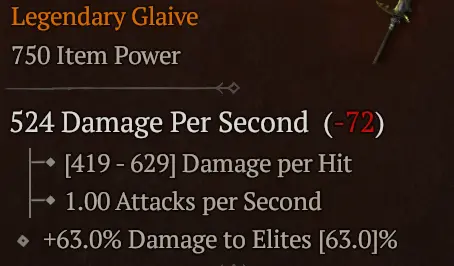
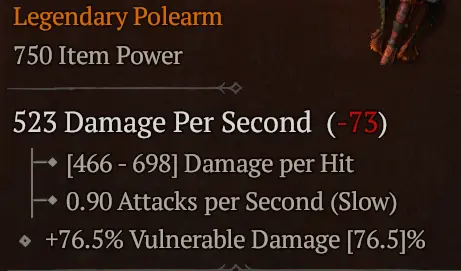
Notice how the Damage per Second (henceforth DPS) is practically identical even though the damage range differs. This is important for builds that aim to one-shot bosses or do the most damage in as few attacks as possible. To calculate the average weapon damage, you use the following formula:


If we compare the average damage for the Polearm and Glaive, we get 582/524 = 1.1106 or an increase of 11.06% damage for the Polearm. We can also calculate the difference in Attacks per Second (henceforth ApS), which you can find underneath the damage range. Glaives have 1 ApS, and Polearms have 0.9 ApS, and the difference between the two is calculated by taking 1/0.9 = 1.1111, or an increase of 11.11% ApS. This means that in a long fight, the DPS for the two weapons would be close to identical from base damage and ApS perspectives.
Another factor to keep in mind when comparing weapons is something commonly referred to as the implicit stat or implicit affix. Right under the weapons ApS, we have a damage stat generally unique to that damage type, and this may vary within the same weapon type for certain unique items. Using the example from earlier, although the weapons have the same DpS, we may value [+]Vulnerable Damage more than we value [+%]Damage to Elites or vice versa. Thus, either weapon may have a higher damage value to our build with all factors included. It is important to understand that while implicit holds value, this stat is typically in the [Additive Damage Multiplier], and its effectiveness and importance can thus vary depending on the situation.
Skill %
Every ability in the game has something that is known as Skill %. This is generally shown just after the damage range of a skill, let us use Dash as an example. The 36.8% is what we call Skill %. Skill ranks often increase this number, and are increased according to the following formula:

Effects such as X'Fal's Corroded Signet have a flat damage number instead. In season 4, the flat damage number has a hidden multiplier that produces the flat damage value you see on the effect when multiplied by your weapon damage. When calculating the average damage from a Flat Damage source, the damage value you see on the item replaces [Skill %] and [Average Weapon Damage] in the [General Damage Formula].
Comparing Damage Gains
When optimizing your damage output, you may ask yourself, “Is option A better than option B”? We can verify this by analyzing the damage multipliers using the relative gain formula we just mentioned. For example, you may wonder if a [x]10% multiplier is more of a damage increase than [+]200% unconditional Additive Damage. To assess this, you first calculate the sum of all additive damage stats before adding [+]200%. Assume you have [+]1000% Additive Damage from stats and paragon points. You then make use of the Relative Gain formula from earlier:

It may be easy to understand that multiplying your damage output by 10% causes you to deal 10% more damage. However, it may not be as clear that adding [+]200% Additive Damage in this example would be an 18.2% increase. In situations where you may wonder if [+]Main Stat, [+]Additive Damage, or a [x]% Global Multiplier adds the most damage, you may also use the Relative Gain formula. Let us assume that you have 700 Main Stat and [+]850% Additive Damage, and you want to know if [+]130 Main Stat, [+]200% Additive Damage, or a [x]10% Global Multiplier results in the highest damage gain. You could then do the following calculations:

In this example, it is clear that adding [+]200% unconditional Additive Damage results in the highest damage gain. Remember that when you compare setups with multiple factors and changes in several or all multipliers, you must include all the multipliers in the comparison, instead of analyzing just one. To do this, look at which multipliers you are affecting and multiply them all together for both setups you are testing. The larger number wins!
Attack Speed
Attack speed in Diablo 4 makes your character attack faster, and how fast you attack depends on two factors. The first one is Attack Speed% (henceforth AS%) sources from stats, items, paragons, aspects, etc, and the second is the ApS of your weapon. AS% is divided into two caps of 100% AS% each for a total of 200% AS%, and the community has named these caps 'Cap 1' and 'Cap 2.' Details on what contributes to each cap can be found in our Attack Speed article. Knowing this information, your ApS can be calculated in the following way:

ApS functions unintuitively and is quite complicated. In short, ApS in Diablo 4 has something called breakpoints, which means ApS between two breakpoints has no value until you reach the next breakpoint. Let us use a practical example for this. Puncture has one breakpoint at 1.9056 ApS and another at 2.07 ApS. If you use daggers, any attack speed between 58.8% AS and 72.49% is useless, as it does not bring you over 2.07 ApS.
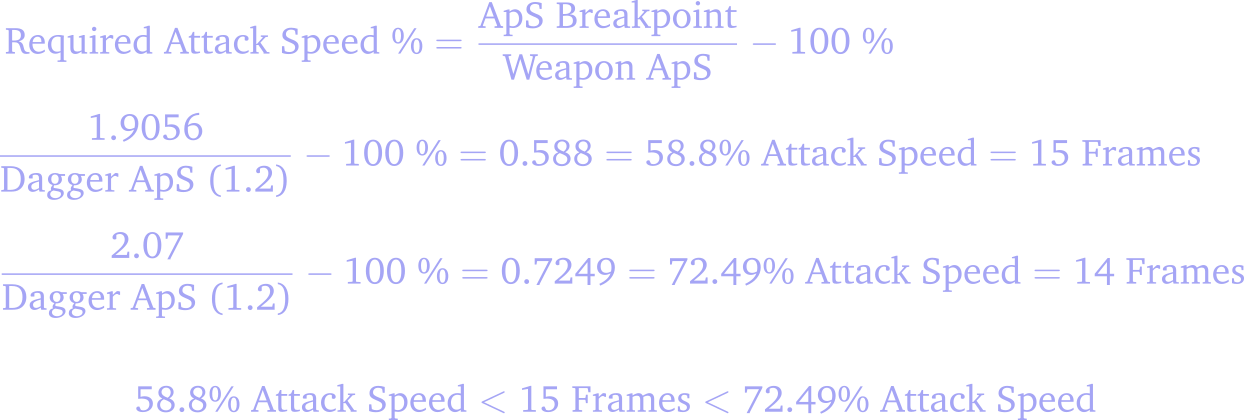
So, between 58.8% Attack Speed and 72.5% Attack Speed, you do not benefit from AS%. This means that when optimizing your damage, you want to be aware of these breakpoints to ensure you do not opt into unnecessary AS%. Using these breakpoints, if you had 60% AS% and added another 15%, you would go from the 15-frame breakpoint to the 14-frame breakpoint. This would result in a Damage per Second increase of 15 Frames / 14 Frames = 1.0714 = 7.14%. If you instead got enough attack speed to go from the 15-frame breakpoint to the 13-frame breakpoint, it would be a Damage per Second increase of 15/13 = 1.1538 = 15.38%. Breakpoints can be found in relevant build guides or the Attack Speed article. Do note that certain skills, such as channeled abilities, do not benefit from Attack Speed in any way.
Our Attack Speed article covers the functionality of Attack Speed much more thoroughly, so head over there for a more detailed explanation.
Tempered Stats
Tempering is accessible through the Blacksmith and is a system that allows you to put additional affixes on items. These tempered affixes do not have to be explicitly damage stats, but those that affect your damage output are briefly mentioned here. This is, by no means, a complete list, and relevant build guides inform you of what is good for specific builds.
| Tempering | Notes |
|---|---|
| [+]% Chance for Skill Projectiles to Cast Twice | This temper is capped at +100% and does not add more projectiles than double at most. |
| [+]% Chance for Skill to Deal Double Damage | This temper is capped at +100% |
| [+]% Skill Duration. | In some scenarios, this reduces the damage dealt per tick (unlike other duration-extending effects in the game). This has no upper cap. |
| [+]% Skill Damage | This temper functions like any [+]Additive stat and is put into the additive multiplier. |
| [+]% Skill Attack Speed% | Most of these belong to the Cap 2 Attack Speed "bucket" except for Wolves Attack Speed which is in Cap 1. |
| [+]% Skill Critical Chance/Damage | The stats from this temper function as normal Critical Strike Chance and Critical Strike Damage but do not work for passives such as Precision. |
| [+]% Skill Size | Increases the size of the skill by increasing its radius, resulting in a quadratic growth of the original size. This is capped at 100% increase of the original radius, which results in a 300% increased area of effect size. |
| [+]% Damage per Combo Point Spent | Rogue-specific tempering option, but tempers like this function as standard [+]Additive damage stats. |
In most cases, you add the tempered stats to the multiplier they belong to, and you are done. However, certain stats like [+]% Chance for Skill Projectiles to Cast Twice may be difficult to conceptualize. Let us use Rapid Fire as an example and say you have [+]50% Chance for Rapid Fire Projectiles to Cast Twice. Rapid Fire normally shoots 5 arrows, so you would multiply 5 arrows by 150% to get the increased amount of arrows per skill used on average: 5 x 150% = 7.5 arrows on average. This is not added to the damage formula as every skill cannot access this temper, but it effectively functions as a [Global Damage Multiplier] to your skill's damage.
Variance
One of the main reasons testing interactions in Diablo 4 proves to be difficult is because of something known as Variance. Variance comes from two different interactions in the game: weapon damage range and skill variance. These two combined cause, up to, an 83% difference between the lowest possible damage instance and the highest possible damage instance. But you may ask, where does the 83% come from? Let us use the Dash ability as an example with its old in-game damage range.

We can calculate the average damage of the skill the same way we would calculate the average damage of a weapon. Once we have calculated the average skill damage of the tooltip, we can check the relative difference between the minimum and maximum damage values compared to the average.
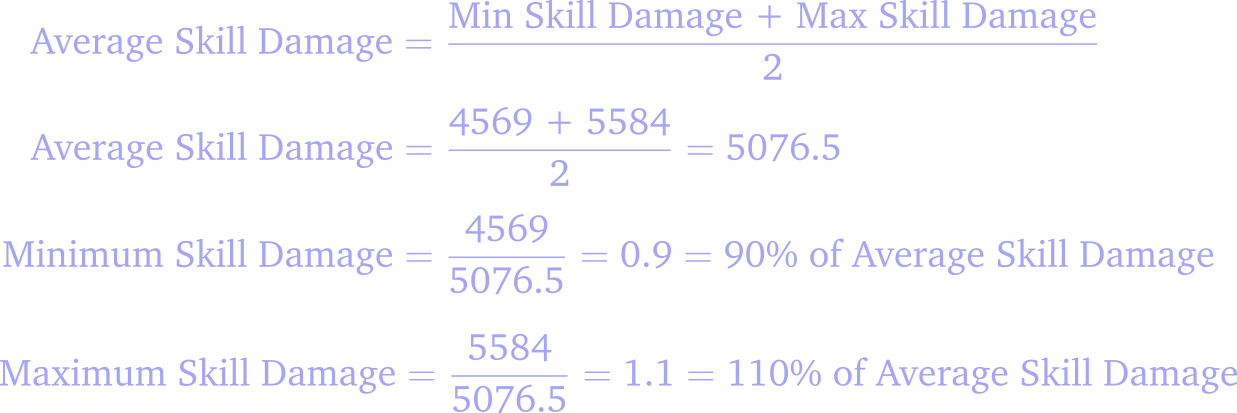
This is what we call skill variance. As we can see, the tooltip variance (lowest to highest) is 90% to 110% of the average damage on the tooltip. This exists for most skills and abilities in the game, and most flat damage aspect powers such as X'Fal's Corroded Signet. The exception to this rule is Damage over Time effects, as long as it is not applied by another skill, such as Poison Imbuement, in which case the usual skill variance still applies.
The damage range on our weapons also causes variance in our damage output. If we use the Glaive in our earlier example, we can use the same method as above to calculate its variance compared to its average.

That means our weapon damage variance can be as low as 80% up to 120% of its average damage. This variance is not used for flat damage aspects, such as X'Fal's Corroded Signet. If we take these two together, it means they compound and we have the following true variance in the game:

Enemy Damage Reduction
If you hover over your level in the character sheet, you notice that it says "Monsters at this Level have xx.xx% visible damage reduction". Using a character of level 60 as an example, enemies take 85% less damage.

This damage reduction appears to be the only way the game currently scales enemy damage intake, as it has been confirmed that bosses do not take more or less damage than normal enemies. Usually, bosses appear to take lower damage due to conditional damage increases not applying correctly. Since Season 6, enemy Damage Reduction has been consistent across all content and depends on your level only.
Summary
- Enable Advanced Tooltips under Options > Gameplay > Advanced Tooltip Information to see the necessary information.
- Stats with [+]% in front of them are summed inside their corresponding multiplier.
- Anything with [x]% is considered a Global Multiplier, often with conditions to when they are applied.
- Global Multipliers often increase the damage dealt more than other damage-increasing stats.
- The Additive Multiplier consists of stats such as Close Damage, Distant Damage, Core Skill Damage, Damage vs ..., Damage to ..., Vulnerable Damage, Critical Strike Damage, and Overpower Damage.
- Use the bottom value of tooltips for stats in the [+]Additive Multiplier for any calculation involving the Additive Multiplier.
- You have more Overpower damage than you think. Make sure to convert your health to Overpower damage, as that is not included in the tooltip.
- Main Stat also increases the damage done by non-skill effects, such as X'Fal's Corroded Signet or Thorns.
- Use the Relative Gain formula when comparing the damage gain of Main Stat, [+]Additive Damage, Skill %, and Global Multipliers.
- Increasing a multiplier results in diminished returns. This applies to all parts of the general damage formula except for enemy damage reduction.
- Damage sources such as X'Fal's Corroded Signet replace weapon damage and Skill % in the damage calculation.
- Attack Speed% is capped at 200%, divided into two smaller caps of 100%. The benefit of Attack Speed depends on the skill, as each skill has unique breakpoints.
- Enemies take less damage based on your level, which caps out at 85% reduced damage at level 60.
Credits
Maintained by Icytroll
Written by Avarilyn.
Reviewed by Northwar.